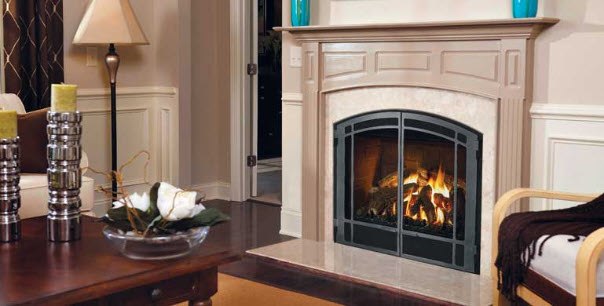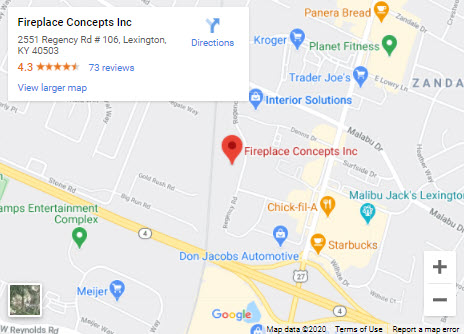Fireplace Terminology

A
Appliance – A fireplace, boiler, furnace, cook stove, heater, water heater, or stove that burns solid fuel or fossil fuel.
AutoFire – AutoFire benefits include lower consumption of fuel and higher outputs that help you to save on energy costs. This is accomplished by dynamically tuning your fireplace for improved efficiency and optimal performance.
B
B-Vent Fireplace – This is a type of fireplace that utilizes air from the inside of your property to fuel combustion. These fireplaces rely on the buoyancy of hot gases as a method to effectively vent the exhaust through the pipe systems that are dedicated to that purpose.
Blower – This is a fan that is driven by an electric motor. It is used for the circulation of air that is done at an increased pace and an increased velocity through the convection chamber of the fireplace.
BTU (British Thermal Unit) – A unit of measurement that is used for energy. A BTU is equal to the energy amount that is required to increase one pound of water’s temperature by a single degree Fahrenheit.
C
Chase – This is the structure that is built around, and encloses areas of the chimney that are exterior to the property.
Circulating Fireplace – This fireplace variety has multi-wall construction around its fire chamber. This allows air to be able to circulate between the walls. It also allows the air to become heated and enter directly into the property.
Clearances – This refers to the minimum distance that has to be maintained between a combustible surface and a heat source. It is composed entirely of an air space. The heat source types include fireplaces and vents.
Co-Axial Direct Vent – This is a type of direct vent system. It consists of a sealed length exhaust pipe that is inside of the same length of a combustion air pipe with a greater diameter. The center pipe is the exhaust while the outer pipe is for fresh air.
Co-Linear Direct Vent – This direct vent system variety is made up of a pair of separate pipes. One is for the exhaust, and the other is for combustion air.
Combustible Material – This is material that is composed of, or surfaced with materials such as plant fibers, wood, compressed paper, or other types of material that are capable of igniting and burning. This refers to these materials in the case that they are in direct contact with, or adjacent to, appliances that produce heat.
Convective Heating – Convective heating refers to natural air movement as it heats and expands. When this happens, it creates a natural airflow as the warmer air moves up while being replaced by cooler air.
D
Direct Vent – The direct vent method for venting an appliance takes all air needed for combustion directly from the outside atmosphere. All gases from the flue are directly discharged into the outside atmosphere. There is no chimney required with the direct vent method.
E
Efficiency – Efficiency in this context refers to the heat percentage that goes into the room being heated as opposed to the percentage that goes up the chimney.
F
Firebox – The firebox is the fireplace’s innermost compartment. It is designed to support fuel combustion.
Flexible Chimney Liner – This is a factory built, listed, continuous, double walled, metal pipe that is flexible. It is used for venting gas appliances. The flexible chimney liner is used exclusively with factory built or masonry chimneys as a way to vent the flue gases vertically to the outside.
Flue – The flue is the chimney’s passageway that conveys flue gases to the atmosphere outside.
G
Gas Insert – The gas insert is an appliance that is designed for installation into the opening of an existing metal factory constructed firebox or a masonry fireplace. This appliance offers a superior efficiency level.
Gas Vent – A gas vent is a listed venting system that is built in the factory. It is designed to effectively remove flue gases to the outdoor atmosphere.
Gravity Vent – This is a venting type that utilizes the natural draft from a warm gasses column that rises because of pressure from the cooler, surrounding air.
H
Hearth – The hearth consists of the surface that is positioned under or in front of the stove or the fireplace. It is sometimes positioned in both places. The hearth is often made from tile or brick.
HeatShift – Used to reduce the surface temperatures for materials directly above the fireplace that are heat sensitive.
L
Linear – A gas fireplace that utilizes a widescreen format.
Liquefied Petroleum Gas – This gas is non-toxic, odorless, and colorless. It is separated from wet natural gas as well as oil refinery gases, and light crude oil.
M
Manifold Pressure – This is a type of gas pressure that takes place between the burner orifice, and the combination valve.
Mantel – This is the shelf that is located above the opening of the fireplace. Typically made of wood, stone, or brick.
Modulating Control – This gives you the ability to control the gas fire’s fuel input automatically.
N
Natural Gas – A fossil fuel variety that is notable for burning clean. This gas is delivered via a pipeline system that runs across North America.
P
Pilot Light – The small flame that is utilized to ignite the main burner’s gas.
Plenum – Used to facilitate excess warm air circulation into a room with higher elevation.
Pressure Test – A method used to check for gas supply line leaks before appliances are installed to it.
Propane – This gas is a non-toxic LPG that contains a higher heat value than natural gas does. It is also odorless, and colorless.
PSI – This term stands for pounds of pressure per square inch.
R
Radiant Heat – This is the heat that moves in waves out from a central point. It heats objects in its path as it moves out. Radiant heat is also defined as harmless, and invisible radiation that emits from a hot object. This radiation converts to heat when absorbed.
Remote Control – This remote control system is wireless and hand held. It gives you control over your fire from any point in the room.
S
Safety Shutoff – This device shuts off the gas supply to the main burner, or the pilot if the ignition source fails. The safety shutoff is powered by a specially designed thermocouple.
Secondary Air – A type of combustion air that is directed in a downstream direction of the primary zone of combustion. It provides support to the combustion of any remaining gases that are combustible. Secondary air does not influence the primary combustion rate directly.
Steady State Efficiency – This refers to the heat ratio or the BTU output as opposed to the heat or BTU input under conditions that are steady.
T
Thermal Efficiency – The heat released in the fire that gets through the appliance so that it can become useful heat inside the property. This is based on percentage.
Thermocouple – This is a device that is composed of two pieces that are made from dissimilar metals. They are joined together at one end. When this end, known as the hot junction, is heated, it allows the production of DC voltage across the other end from the thermocouple. The thermocouple is used in the powering of gas valves.
Thermostat – This automatic device regulates a building’s temperature through the control of a heating or cooling unit. The thermostat acts as an on/off switch. It does not modulate the source of heating or cooling.
U
Unvented – This is a hearth appliance that draws the combustion air it utilizes from inside the home. It is also known as vent-free and it is designed to be able to burn at a level of efficiency that eliminates the need to vent.
V
ValorStat – This is a piece of equipment that comes standard with the majority of models from Valor. It controls key aspects of your Valor gas fireplace. These aspects include aesthetics, comfort, and convenience.
Z
Zero Clearance Fireplace – This is a unit that is factory built and then installed into a combustible construction.

